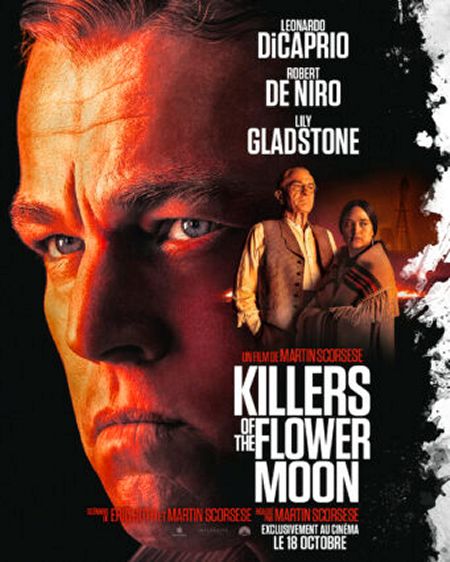"KILLERS OF THE FLOWER MOON" AN ASSUME WESTERN ON THE GENOCIDE OF THE OSAGE INDIANS |
|
The New York filmmaker brings together his favorite actors for a major fresco set in Oklahoma in the 1920s Robert De Niro and LeonardoDiCaprio A film that Martin Scorsese has carried with him for many years. “The film has been in preparation for 7 or 8 years,” said Leonardo DiCaprio last May in Cannes, adding “I know that Marty (Scorsese) spent months, a year there (with the Osage) collecting their stories, to try to get as close as possible to the truth. (...) One hundred years after the massacre (of the Osage), we had the opportunity to speak to direct descendants of the tragedy, to listen to their stories." underlines the actor. In 2016, Martin Scorsese discovered the captivating work of David Grann, master of literary investigation. Intrigued by the title, Killers of the Flower Moon, he was struck by the gentleness and brutality it suggested. The writer revisits the atrocities committed against the Osage Native Americans in the 1920s and decides to make them the basis of his film “One of the most heinous crimes” He sets out to relate "one of the most heinous crimes and racial injustices perpetrated by white settlers against Native Americans, motivated by the lure of oil profits", explains the author. The state of Oklahoma, 1920s. Oil brought wealth to the Osage Indians...much to their chagrin. The tragedy of the Osage Indians had an enchanted interlude, worthy of a fable. Driven from Kansas at the end of the 19th century for the benefit of white settlers, these Native American people were relegated to an arid corner of Oklahoma. A barren land from which one day geysers of black gold gushed. Thanks to this oil field, the largest in the United States, the Osage Indians became incredibly wealthy. Like nabobs, they owned vast estates and hired workers, arousing everyone's desire. White criminals then used the worst methods to seize their fortune from the oil boom: scams, poisonings, marriages of interest, bullets in the head. Fascinated by this forgotten page of history, the filmmaker decides to bring it to the screen. She embodies the matrix of his obsessions with greed, organized crime and the essence of evil. How can we do justice to a people marked by drama and ignored by cinema? Lily Gladstone and Leonardo DiCaprio meet descendants of the Osage tribe, including Margie Burkhart, the heroine's granddaughter. “I saw a lot of Mollie in her. Her laugh, her strength, her skepticism sometimes. I understood how this drama had impacted subsequent generations.” Thus was born the most memorable scene in Killers of the Flower Moon. We see Mollie and Ernest sitting side by side at a table: him, staring at the ceiling with a focused look; she, a blanket on her shoulders, giving him a tender look. For two years, this image represented the only glimpse of Martin Scorsese's feature film. The actress relies on an anecdote collected during her research. A man tells him about his grandmother Rose's ritual in times of storm: “When she heard lightning, she would sit down, cover her shoulders and welcome all this force in calm. In the original script, the scene just ended with Mollie pouring herself a glass of whiskey. » On screen, the entire dynamic of the couple is also revealed in this key moment: one rejoices in the benefits of the rain on the crops, while the other urges him to silently embrace the unleashings of the rain. nature. An assumed western The film takes on classic Scorsese themes: a story of violence, criminals and love, but it is also perhaps one of his most political films. It depicts how white men dispossessed members of a Native American people, the Osage, on whose lands oil was discovered in the 1920s. The way Native Americans were treated in the centuries after the colonization of the America by Europeans "remains a wound to be healed", he declared during the Cannes festival, where the film was presented out of competition. In an assumed western atmosphere, with the arrival of the hero in the small town of Fairfax aboard a train, the pipe ceremony and the oil wells, the small community will suddenly be the victim of a series of murders and of disappearances. With this film, Martin Scorsese also realized his dream of a western, a genre which reached its peak "in the 20th century and which has disappeared today". “I loved westerns, they reflected who we were then and who we still are, in some ways.” “Maybe by knowing our history and understanding where we are, we can make a difference and live up to what our country is supposed to be,” said the American filmmaker. “Let’s just show the story and see what happens." |
|
| Kelly Donaldson for DayNewsWorld | |
 |
|




